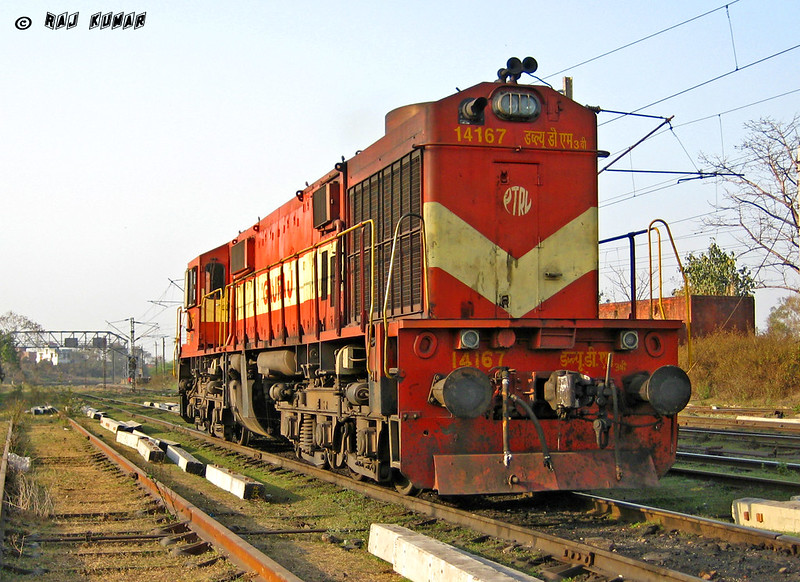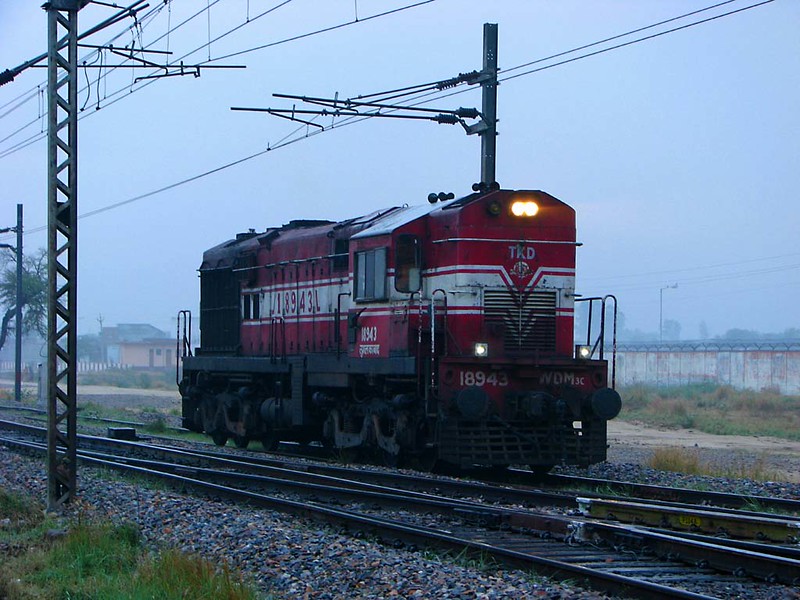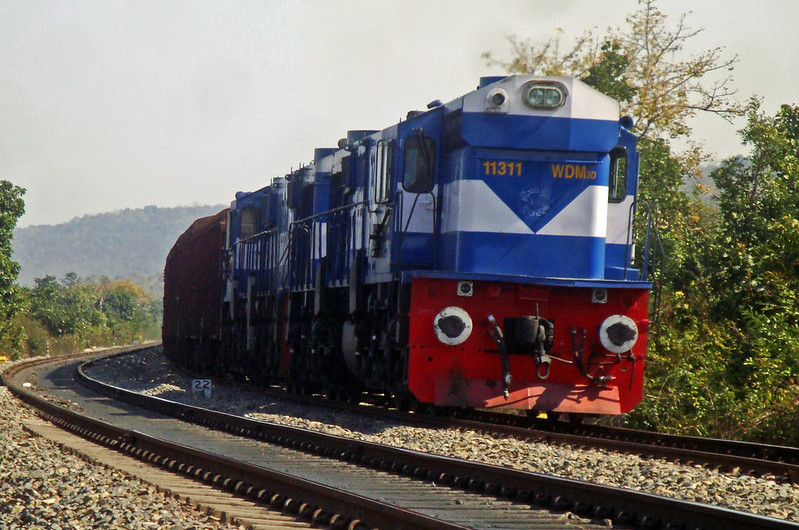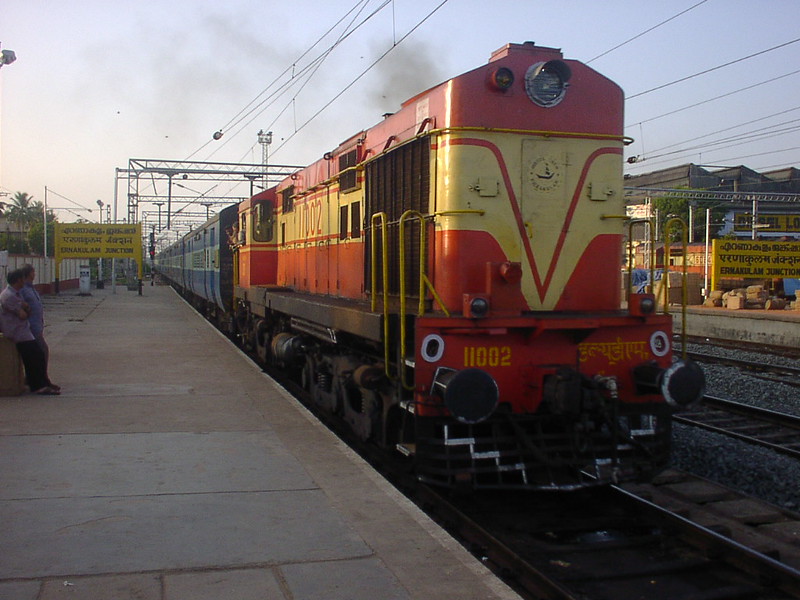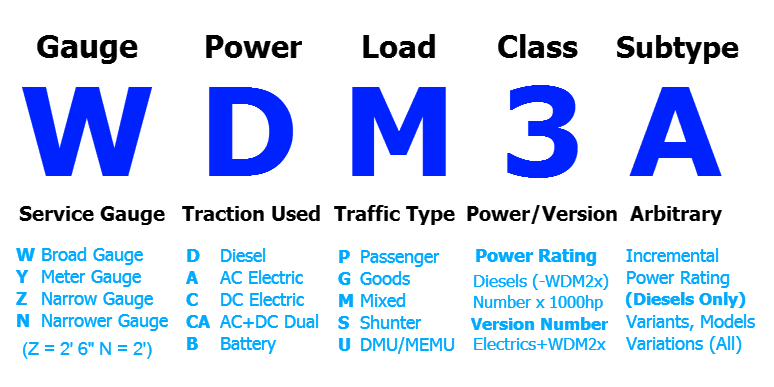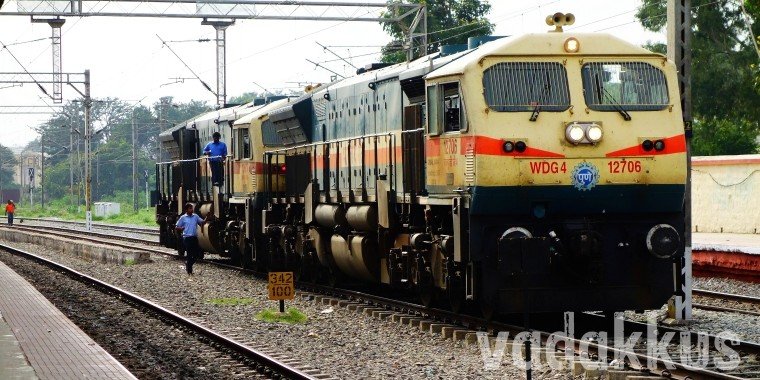Diesel Locomotives Roster – The WDM (ALCO) Series
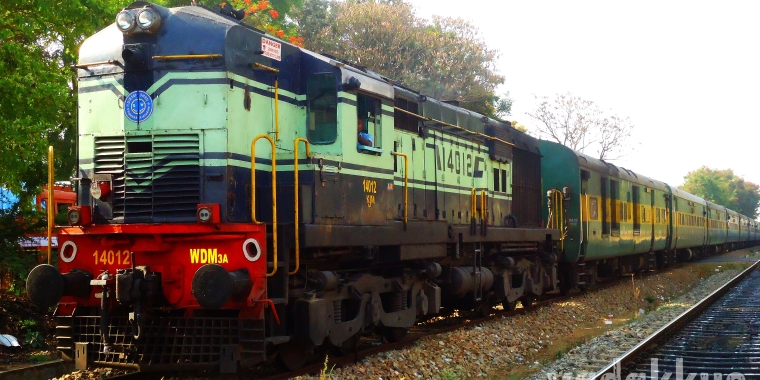
The WDM class were built as the general handyman locomotives of the Indian Railways. They are the most basic of all locomotives in India. For a long time they were the most popular, the most adaptable and the most widely used. They also have been around the longest and hence have the most number of people qualified to work and service them. They can fit into any schedule as they can haul anything and run anywhere. And except for the WDM4, all of them were ALCOs based on the WDM2, with later models being the same old ALCO with its faithful 251B prime mover (engine) rebuilt and rebuilt to crank more power out of it.
Once the mainstay of the Indian Railways, ALCOs are today a vanishing breed, as electrification of lines is advancing rapidly and more modern EMDs are taking over any remaining diesel routes. All ALCO models have ceased production today. They will all vanish from service in less than half a decade.
Diesel locomotives are built and maintained in India at the Diesel Locomotive Works (DLW), Varanasi or at the Diesel-Loco Modernisation Works (DMW), Patiala.
Here are the 13 WDM series locos. Click here for the WDP and WDG Series engines
WDM1
- Supplied by ALCO, USA, all imported
- The first diesel locomotives in India
- 12-Cylinder 4-Stroke Turbocharged Diesel
- Rated Power Output: 1900 hp
- Production Period: 1957 to 1959
- Number Produced: 100
- Wheel Arrangement: Co-Co
- Top (Rated) Speed: 100 kph
The very first diesel mainline locomotives in India, part of ALCO’s DL500 World Series locomotives lineup. Classic American “butch” good looks with only one forward cab at one end which necessitated a lot of turntables. They were housed at Bondamunda (Rourkela), Vizag, Gonda, Patratu and Gorakhpur, serving present-day NER, ECR, SER, ECoR and SCR. It was relatively underpowered by today’s standards, but still hauled most of the first dieselized expresses in India. All were imported fully built and some were in service until 2000. Today all are withdrawn and most are scrapped, though many of the same kind are still in service in Pakistan, Sri Lanka, Kenya, Greece etc. Their heyday was before the large-scale advent of cameras and hence not much information or pictures are available of them. The very first WDM1 #17000 is on display in the National Rail Museum, New Delhi.
WDM2
- 12-Cylinder 4-Stroke Turbo Diesel (Alco 251B)
- Originally ALCO DL560C
- Rated Power Output: 2600 hp
- Production Period: 1962 to 1998
- Number Produced: 2700+
- Wheel Arrangement: Co-Co
- Top (Rated) Speed: 120 kph
- Supplied by ALCO, USA and later manufactured at CLW, DLW
For a long time, the WDM2 ALCO was the quintessential Indian locomotive, the picture that comes to the mind of the average Indian when you say “Locomotive”, with it’s Hood Unit cab and long, narrow body. The WDM2 was the workhorse that powered the Indian Railways to what it is today and set the standard for all Diesel Locomotives for more than four decades. However, these definitive “Indian” locomotives are actually American.
The history of the WDM2 goes something like this: After Indian Railways decided to shift from steam to diesel traction, they started looking out for modern diesel locomotive perfect for Indian conditions. ALCO’s DL560C and GM’s SD24 (as GT16 for India) were shortlisted, and the ALCO was selected because they agreed for technology transfer so these locomotives could now be owned by Indian Railways. The ALCO DL560C was classified the WDM2 and with it started the present saga of the ALCOs in the Indian Railways. The SD24 would become the WDM4. The first DL560Cs were imported starting in 1962 and later mass-produced in India.
The ALCO was perfect for “Indian conditions”, rugged, very reliable, powerful enough, had simple construction and mechanics and was easy to operate and maintain and was very malleable, enabling engineers to tweak and tinker with the engine to produce different versions of it, even increasing the cylinders from 12 to 16 later on. ALCOs hauled most premier Expresses, many of them double-headed as a single WDM2 could haul only 12-14 coaches. The seemingly indestructible ALCO engine in its various forms is going strong even today after ruling the Indian Diesel scene singlehandedly for 37 years! It is no longer in production today, the last WDM2 (#16887) rolled out on August 1, 1998.
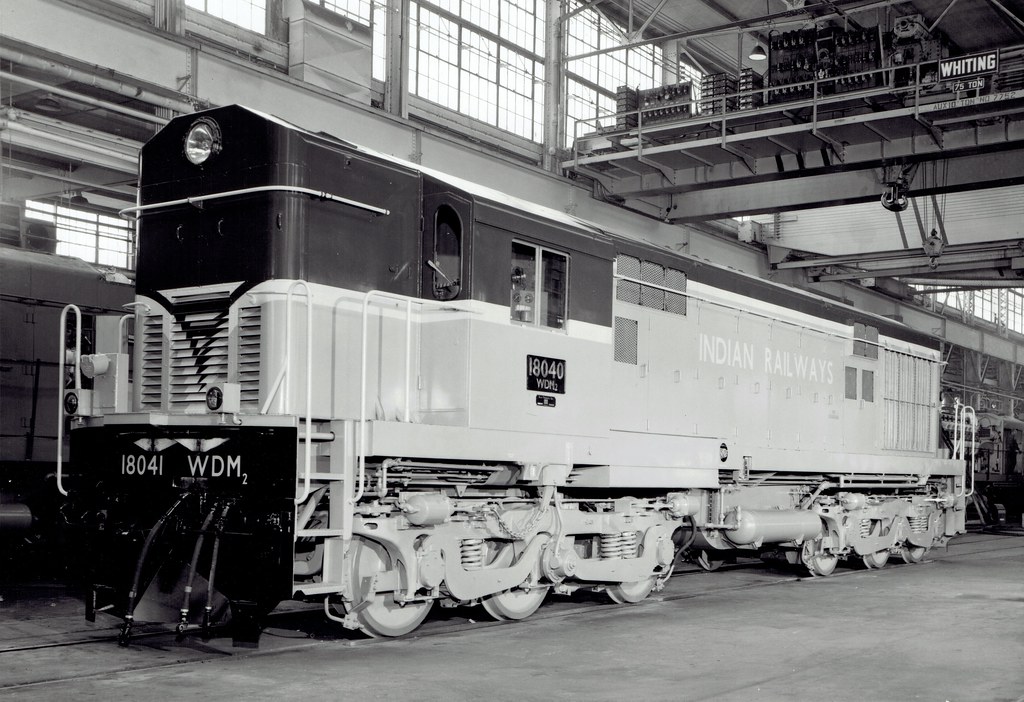
All Diesel Locomotives in India except the WDM4 and WDG4/P4X EMDs are based on the WDM2 ALCO as they use the same old ALCO 251 diesel engine in various upgraded guises, not to mention the looks. WDM2s are still in service though their numbers are fast dwindling as they are either being withdrawn or converted to WDM3A. The very first ALCO, the #18040 is preserved at the NRM, Delhi. The WDM2 has some variants :
Jumbos: Locos with a rebuilt short hood with big windows. Looks a bit like an elephant? Here.
WDM2A: WDM2s rebuilt to feature Air Brakes. The initial ones had only vacuum brakes.
WDM2B: WDM2s with Air Brakes as standard equipment. Only a few are classified so.
WDM2S: WDM2s relegated to shunting duties when their service life was nearing completion.
WDM2G
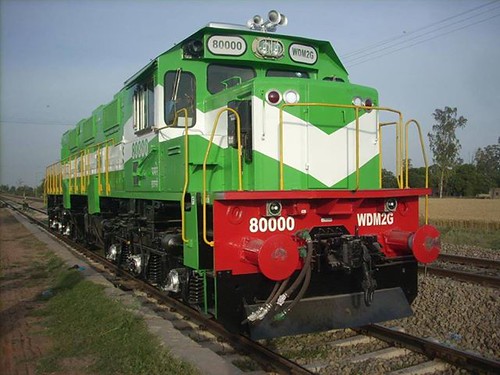 Latest, Unique Multi-Genset Locomotives
Latest, Unique Multi-Genset Locomotives- Has three 800 hp engines (Gensets) in Parallel instead of a single prime mover.
- Rated Power Output: 2400 hp (800 hp x 3)
- Production Period: 2013 –
- 2 built (80000 and 80001)
- Wheel Arrangement: Co-Co
- Top (Rated) Speed: 120 kph
- Based on the WDM3D without the ALCO engine
- Tremendously energy efficient, multipurpose locomotives fully Made in India
A breakthrough in locomotive technology, the unique WDM2G is a testimony to the brilliant engineers at RDSO and Indian Railways. This is the latest ALCO, based on the WDM3D with it’s same underframe and high-adhesion bogies. The single 3300 hp engine of the WDM3D has been replaced by three 800 hp “gensets” which can work individually in parallel. This means that one, two or three of the Gensets can be operated depending on the situation and power required, translating into tremendous energy-efficiency (two engines can be shut down while running light or idling). It seems under-powered, but it has been developed intentionally as a low-powered loco to address the gap left behind by the WDM2. The WDM2G is ideal for an entire range of low-power duties like hauling small passenger trains and expresses of 10-12 coaches, departmental duties, at many industrial sites and for shunting. The WDM2G can relieve all the higher powered locos wasting away doing these duties currently, bringing about a lot of process streamlining. It is completely indigenous, designed, developed and made in India! Looks only vaguely like the Indian ALCOs and more like some American locomotives (CSX etc). Two WDM2Gs have been produced and are both at Itarsi, the numbering scheme indicates many more are to come. It does not follow the IR naming convention, the “G” probably stands for “Genset”.
WDM3
- Imported Henschel & Sohn DHG 2500 BB
- Mercedes Diesel Engine
- Rated Power Output: 2300 hp
- Production Period: 1970
- Number Produced: 8
- Wheel Arrangement: B-B
- Top (Rated) Speed: 120 kph
Not much is known about WDM3 locomotives but they were possibly the result of IR trying out a different manufacturer. There are no details available about what these locos were used for, where they were housed or what they did, not even a photo is available. They were reportedly decommissioned in Gooty in 1995, so they were in service for 25 years. And these locomotives were diesel-hydraulic, an anomaly in India where all other locomotives are diesel-electric! No WDM3x locos in service today has got anything to do with these locos.
WDM3A
- 16-Cylinder 4-Stroke Turbo Diesel (Rebuilt Alco 251C)
- Rated Power Output: 3100 hp
- Production Period: 1994 to 1998
- 158 built, 700+ rebuilt WDM2s (Total 1200+)
- Wheel Arrangement: Co-Co
- Top (Rated) Speed: 120 kph
- Based on the WDM2, upgraded by DLW.
Thanks to “chalta hai” complacency, it took 42 years for the Indian Railways to come out with a new diesel locomotive after the WDM2! Even then, the WDM3A was just a reincarnation of the same old ALCO. The 12 cylinder ALCO engine was rebuilt with 16 cylinders to output 3100 hp. These were initially classified WDM2C but later changed to WDM3A (for 3100 hp) as per the new classification scheme. Though there are around 1200 WDM3As today, only some 150 odd were originally built as WDM3As, most of them “baldies” like the one in the picture. The rest are WDM2s with their engines rebuilt to output 3100 hp. Rebuilt WDM3As can be identified by a “R” at the end of their Road Number. Some of these have DBRs fitted on their short roof which makes it look like they have a “hoodie” covering their short hood top, a predominantly WDM3D feature. The WDM3A also laid the foundation for the remaining WDM3x series. Most of the “ALCOs” seen today are WDM3x series and not WDM2s. All dimensions of the WDM3A are identical to the WDM2, except for the baldies.
WDM3B
- 16-Cylinder 4-Stroke Turbo Diesel (Alco 251C)
- Rated Power Output: 3100 hp
- Production Period: 2005 to 2006
- 23 built. Most rebuilt into WDM3D
- Wheel Arrangement: Co-Co
- Top (Rated) Speed: 120 kph
- Stripped-down version of the WDM3D
The WDM3B diesel locomotive class was developed in 2005 after the WDM3C and WDM3D. It actually is a variant of the WDM3D, though it shares its power rating with the WDM3A. Only 23 numbers were built (road numbers #14144 to #14167), making them very rare. It has the same engine as the WDM3D, despite having a power deficit of 200 hp. It also looks the same, shares the same body shell, control cabin, undercarriage and the high-adhesion bolsterless bogies of the WDM3D. The difference is that unlike the WDM3D, the WDM3B is not microprocessor controlled but uses something called “E-Type Excitation” for locomotive control. The WDM3B seems to be the result of the Railways trying to cut the WDM3D down to size by eliminating its troublesome features like microprocessor control. But now 3Bs are being converted into 3Ds. WDM3Bs are housed at UP sheds like Lucknow, Gonda, Jhansi, Samastipur, Patratu etc. and many are (were) famously named “Gajraj”. The WDM3B does not adhere to the hp-based naming convention as WDM3A already represented 3100 hp. IR just assigned the vacant WDM3B class to this type.
WDM3C
WDM3Cs were only upgraded and more powerful WDM3As with the ALCO engine again rebuilt to output 3300 hp. It was the first follow-up experiment after the WDM3A to squeeze more power out of the ALCO engine, an intermediary that would later lead to the development of the WDM3D. Not many were produced, all of which were rebuilds of the WDM2 or WDM3A and were identical to the ALCOs in every aspect. You cannot find these anywhere today because all have been reverted back to WDM2 or WDM3A.
WDM3D
- 16-Cylinder 4-Stroke Turbo Diesel (Alco 251C)
- Rated Power Output: 3300 hp
- Production Period: 2003 to today.
- 344 built. 20 rebuilds included.
- Wheel Arrangement: Co-Co
- Top (Rated) Speed: 160 kph
- Based on the WDM3A with EMD features.
While still being based on the good old ALCO, the WDM3D was a path breaking kind of locomotive for the Indian Railways, the “real” next generation” after the WDM3A. With the WDM3D, IR finally got it right on how to rebuild the old ALCO engine to produce 3300 hp. By this time, EMDs had become a staple of the scene and along with the rebuilt engine, the brilliant DLW and RDSO engineers were now successful at integrating the best features of EMD locomotives like microprocessor control, larger fuel tanks and oil sump, possible fiberglass cabin and improved control stands into the ALCO, making it a kind of EMD-ALCO hybrid!
These locomotives can be easily distinguished from other ALCOs by the “narrower” body shell with lots of walkway space around it, full-length railings, predominant “platform” space extended up front of the long hood, solid cowcatcher and DBRs fitted on the roof of the unblemished, smooth short hood for some later models and rebuilds, giving them the “hoodie” look. The WDM3D can carry 1.5 tonne more axle load and generates 8 tonnes more Maximum Tractive Effort compared to the WDM3A. The engine is classified WDM3D though it outputs only 3300 hp and not 3400 hp as the name should suggest. Earlier WDM3Ds had issues with their electronics which probably led to the interim development of the WDM3B in 2005, basically a lower powered WDM3D without microprocessor control. Their Road Numbers start from #11001. The WDM3D was the last ALCO model in production. The last WDM3D produced, #14166, was named “Velociti”.
WDM3E
- 16-Cylinder 4-Stroke Turbo Diesel (Alco 251C)
- Rated Power Output: 3500 hp
- Production Period: 2008
- 8? built and all converted to WDM3D
- Wheel Arrangement: Co-Co
- Top (Rated) Speed: 105 kph
- Experimental class based on WDM3D
The WDM3E was again an experimental class developed out of the WDM3D by IR on the ever-lookout for more power, all equipped with High Adhesion bogies and roof-mounted DBRs. However, they never entered serial production. Some suggest that the WDM3E is actually called “WDM3D without Equalizer” or WDM3Ds with 3500 hp power. The known road numbers in service for this class are #11306 to #11311 and #11263. All are marked WDM3D and all are used to haul only freights with speed restricted to 85 kph. They look exactly like the WDM3D and share all its features.
WDM3F
- 16-Cylinder 4-Stroke Turbo Diesel (Alco 251C)
- Rated Power Output: 3600 hp
- Production Period: 2008
- 4 built and in service
- Wheel Arrangement: Co-Co
- Top (Rated) Speed: 105 kph
- Extremely rare to find.
- Based on the WDM3D
The very extremely rare WDM3F was the result of the last and final experiment in IR’s drive for more powerful ALCOs. This one is rated 3600 hp and only 4 were produced (#11287, #11321, #11325, #11342). #11287 has a unique aerodynamic design where the ends taper upwards (picture above). All WDM3Fs are based at Gooty (GY) and share all the features of the WDM3D including roof mounted DBRs except the #11287. Though high powered, this class apparently didn’t work out well because after the WDM3F, IR realized that it is futile to try and crank more power of the ALCOs as they were too old and outdated and shifted attention to the EMD. This also marked the beginning of the end of the ALCO domination on Indian Railways.
WDM4
- 16-Cylinder 2-Stroke Turbo Supercharged Diesel
- Model SD24 (GT16) of GM-EMD.
- Rated Power Output: 2600 hp
- Production Period: 1962
- 72 all imported
- Wheel Arrangement: Co-Co
- Top (Rated) Speed: 130 kph
- First EMD locomotives in India
The WDM4 was originally General Motors-EMD SD24, given model number GT16 for the India export version, was the competitor to the ALCO DL560C in IR’s lookout for its perfect diesel loco in 1962. It lost out to the ALCO despite being technically superior and faster that it because as per the lore goes, GM was not willing to give technological transfer rights to Indian Railways. They were all imported from the USA. It was a WDM4, #18110, that had the honor of being the engine hauling the very first Rajdhani Express on its inaugural service from Howrah to Delhi on March 3, 1969. WDM4s remained the dedicated link of the Howrah Rajdhani, double headed even, until the late 1970s. Many other prestigious expresses, especially on the Delhi-Howrah route, boasted of the WDM4 as their first Diesel link on switchover from steam. They introduced India to high-speed diesel runs and were the forerunners of the GT46MAC that would arrive in India 40 years later as the WDG4. They looked somewhat same as the ALCOs with their hood unit cabs. All are decommissioned now and one is on display at the National Rail Museum, New Delhi.
There was no WDM5.
WDM6
- 6-Cylinder Inline, 4-Stroke Diesel (ALCO 251D6)
- Rated Power Output: 1350 hp
- Production Period: 1982
- Only TWO were built.
- Wheel Arrangement: Bo-Bo
- Top (Rated) Speed: 75 kph
- Mainline Loco with Shunter specifications.
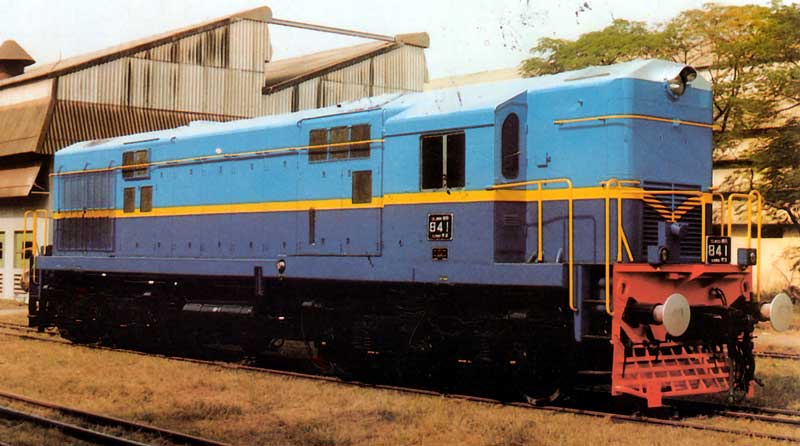
The WDM6 is an aberration, a little locomotive that was too diminutive to do anything substantial. Though classified as a mainline BG locomotive, this ALCO had all the specs usually reserved for shunting locomotives including a low powered prime-mover, fabricated Bo-Bo bogies and low top speed. It actually had the same specs as the WDS6 shunter which was already in production. The engine was one with some minor tweaks, the same ALCO used in Meter Gauge diesel locomotives. It also lacked the “ALCO looks” with a high, hooded cab and had only two of its kind produced. One (#18901) is retired the other one (#18902) is supposed to be still puttering around Bardhhaman. Maybe IR was experimenting with low powered locos to pull local trains. (Pictured above, another version of the WDM6 built for export to Sri Lanka). This was not included in the new classification scheme. UPDATE: The only surviving WDM6, #18902 has been overhauled by the BWN shed, giving it a new lease of life, bringing it back from the verge of extinction! Bless you Barddhaman, for giving this little loco a new lease of life!
WDM7
- 16-Cylinder 4-Stroke Diesel (ALCO 251D16)
- Rated Power Output: 2000 hp
- Production Period: 1987-1989
- 15 were built and all are still in service.
- Wheel Arrangement: Co-Co
- Top (Rated) Speed: 105 kph
- Low powered version of the ALCO.
The WDM7 was another loco that stood out from the rest. 15 of them (#11001 to #11015) were built as a low-powered, “lightweight” version of the original ALCO and were the first “standout” mainline version of the ALCO to be produced after the WDM2, 25 years later! Funny that the first two ALCO models are at the either ends of the naming scheme. Again, like the WDM6, maybe IR wanted a lower powered locomotive to handle small rake local and passenger services. However, all sheds declined them and they ended up at ERS where they were used to handle local and shuttle services (NBR-SRR-ERS-KTYM/ALLP-KYJ-QLN-TVC-NGJ) with good degrees of efficiency. Becoming aware of their abilities, SR moved all the WDM7s out of Ernakulam to Tondiarpet (TNP) where they are housed today. One (#11008) has been modified to run on Bio-Diesel. They look exactly the same as the WDM2 except for the “clean” SHF nose.
The railways are moving away from Mixed type locomotives and is now following the policy of dedicated locomotives for passenger and freight services. ALCOs had been serving as WDPs and WDGs for quite some time now, but as ALCOs were generally getting long in the tooth, IR is now tinkering with the more modern EMDs as WDPs and WDGs. More about those locomotives classified as such in the next part.
More Chapters on Indian Locomotives
Locomotives of the Indian Railways | Locomotives Terminologies and Design
How Locomotives are Classified | How Electric and Diesel Locomotives Work
DIESELS: The WDM Series (ALCOs) | The WDP and WDG Series (ALCOs and EMDs)
ELECTRICS: DC and AC/DC Locos | The WAM Series (AC mixed) | The WAG Series (AC Freight)




